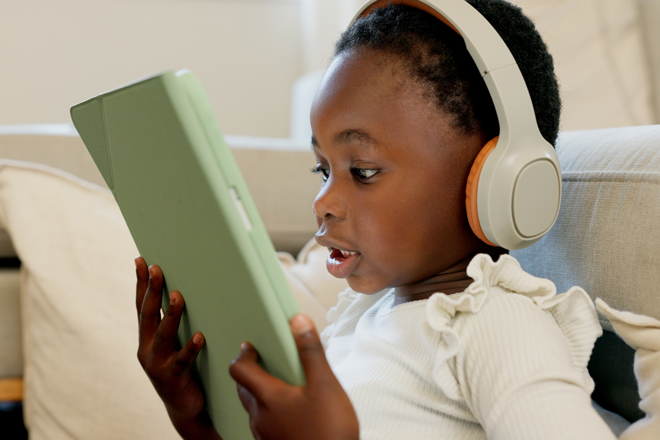Online video watching is at an all-time high

Toddlers and preschoolers today are spending more time watching videos on online streaming services like YouTube than in any other format (The Comon Sense Census, 2020). According to a 2020 report, children’s time watching videos online more than doubled between 2017 (18 minutes per day) to 2020 (39 minutes per day). This is not surprising, considering more than half of these young children have their own mobile devices (e.g., smartphones, tablets).
The sheer volume of online content is staggering. Every minute, YouTube users upload an astonishing 500 hours of content. This makes it incredibly difficult for any parent or caregiver to keep track of what young children are exposed to when they browse YouTube.
In March 2023, our team of children’s media researchers at SRI spoke with 13 parents of young children (in preschool through first grade) across the country to understand how parents and young children were navigating the new digital media landscape. Because YouTube is so popular with kids, we talked with parents who said their young child watched YouTube often, and we asked about their experiences with both YouTube and YouTube Kids.
Online safety is a top concern for parents, both on YouTube and YouTube Kids
Although YouTube met a range of needs for these families, many parents admitted that they didn’t trust it. Parents described protections and features that might make them more comfortable allowing their children to browse YouTube, such as the following:
– Parent of a first-grade child
 Parental control capabilities. Parents wanted a feature to block specific keywords (e.g., gun, kill) similar to blocking specific videos or channels.
Parental control capabilities. Parents wanted a feature to block specific keywords (e.g., gun, kill) similar to blocking specific videos or channels.
 Options to filter content based on format, age, and areas of interest. Parents wanted to be able to opt in to professionally produced videos (e.g., TV-show episodes) and opt out of user-generated or “influencer” content that may not be age-appropriate.
Options to filter content based on format, age, and areas of interest. Parents wanted to be able to opt in to professionally produced videos (e.g., TV-show episodes) and opt out of user-generated or “influencer” content that may not be age-appropriate.
Families also acknowledge the benefits of YouTube

Despite their concerns, parents acknowledged that YouTube offered benefits for their families.
Parents appreciated that YouTube or YouTube Kids provided the following:
- Online videos that kept their kids entertained and occupied when parents were busy or when kids needed to unwind from school.
- A space for kids to explore and learn about their unique interests.
- Parental control settings to monitor and filter content (although, as noted above, parents wanted more controls to filter out inappropriate content).
- High variety of content for all ages (as one parent of a Kindergartener put it: “there is something for everyone”), including a good selection of educational videos.
Our research team was most interested in this “educational” element of online videos. It brought us to wonder: What does educational content look like on YouTube? Can kids really learn from these videos?
Educational videos exist on YouTube, but high-quality ones are harder to find.
– Parent of a PreK child
The Common Sense Census (2020) documented that parents generally approved of the educational content that their children watched on YouTube. In fact, 72% of parents said that they believed that online media contributed to their children’s learning. But unfortunately, very little is known about the content or quality of the educational videos that children watch online. Early research suggests the quality of online educational videos, on average, may be quite poor. In fact, one recent study found that only 1 in 20 videos children watch online were of high educational value (Young Kids and YouTube, 2020).
Our research team is interested in how online videos portray and teach educational content. Collectively, our team watched over 1,000 early math and literacy YouTube videos. We discovered that many online educational videos differ from typical educational TV shows in that they may be less likely to include on-screen characters, and they often fail to integrate educational content into a storyline.
Takeaways for parents and caregivers
Children are increasingly watching online, user-generated videos, and parents and caregivers should be aware that these videos differ from TV shows in important ways that may affect their ability to engage and teach kids. We offer a couple of suggestions for ways parents and caregivers can be more involved in their child’s use of YouTube:
 Talk with your child about what they learn from educational online videos, and what they like about them. It can help kids get more out of the videos they watch and for you to learn more about their new interests!
Talk with your child about what they learn from educational online videos, and what they like about them. It can help kids get more out of the videos they watch and for you to learn more about their new interests!
 Help your child search for videos to watch using keywords based on their interests or a specific skill they are working on (e.g., “counting song”). This will yield more relevant – and possibly more engaging – results compared to searching based on their age (e.g., “kindergarten math”). It may also help you to review the content and sites before they visit, offering a shared learning activity.
Help your child search for videos to watch using keywords based on their interests or a specific skill they are working on (e.g., “counting song”). This will yield more relevant – and possibly more engaging – results compared to searching based on their age (e.g., “kindergarten math”). It may also help you to review the content and sites before they visit, offering a shared learning activity.
There is a great need to understand the content and quality of these user-generated videos as a context for children’s early learning and development. Our research team is working to understand what kinds of educational media exist on large and public platforms such as YouTube, how children are finding videos to watch, and what, if anything, they might be learning from these videos.
To read our recent report with more information on our findings, click here!
References
Radesky, J. S., Schaller, A., Yeo, S. L., Weeks, H. M., & Robb, M. B. (2020). Young kids and YouTube: How ads, toys, and games dominate viewing, 2020. Common Sense Media. https://www.commonsensemedia.org/research/young-kids-and-youtube-how-ads-toys-and-games-dominate-viewing
Rideout, V., & Robb, M. B. (2020). The Common Sense census: Media use by kids age zero to eight.
Common Sense Media. https://www.commonsensemedia.org/research/the-common-sense-census-media-use-by-kids-age-zero-to-eight-2020
Topics: Early childhood Family engagement Social-emotional learning
Tags: Social Media
